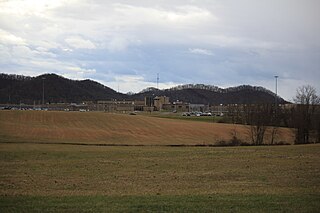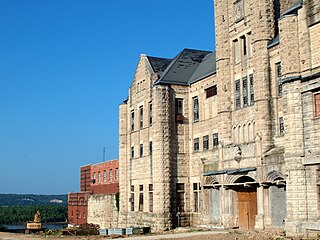
Minnesota Correctional Facility – Oak Park Heights (MCF-OPH) is Minnesota's only Level Five maximum security prison. The facility is located near the cities of Bayport and Stillwater. The facility is designed and employed with trained security officers to handle not only Minnesota's high-risk inmates but other states' as well. They also have the largest contract to house federal inmates with serious, violent histories. The prison has never had an escape, and only one homicide.

The Correctional Service of Canada, also known as Correctional Service Canada or Corrections Canada, is the Canadian federal government agency responsible for the incarceration and rehabilitation of convicted criminal offenders sentenced to two years or more. The agency has its headquarters in Ottawa, Ontario.
Saskatchewan Penitentiary is a Medium Security Facility with Maximum Security areas. It is located on a walled 20-acre parcel of land in the Rural Municipality of Prince Albert No. 461, one kilometre west of Prince Albert, Saskatchewan, Canada. It opened in 1911 built on the site of a former residential school run by the Anglican Church of Canada.
The Iowa State Penitentiary (ISP) is an Iowa Department of Corrections maximum security prison for men located in the Lee County, Iowa, community of Fort Madison. This facility should not be confused with the Historical Iowa State Penitentiary, which was shut down in 2015 after being open for 175 years. The HISP itself was a 550-person maximum security unit. Also on the complex was a John Bennett Correctional Center - a 169-person medium security unit. The HISP included two minimum-security farms with about 170 people who were located within a few miles of the main complex. The complex also had a ten-person multiple care unit, and a 120-bed special-needs unit for prisoners with mental illness or other diseases that require special medical care. In total, there were about 950 inmates and 510 staff members.
Millhaven Institution is a maximum security prison located in Bath, Ontario. Approximately 500 inmates are incarcerated at Millhaven.

Oregon State Penitentiary (OSP), also known as Oregon State Prison, is a maximum security prison in the northwest United States in Salem, Oregon. Originally opened in Portland 173 years ago in 1851, it relocated to Salem fifteen years later. The 2,242-capacity prison is the oldest in the state; the all-male facility is operated by the Oregon Department of Corrections (ODOC). OSP contains an intensive management wing, which is being transformed into a psychiatric facility for mentally ill prisoners throughout Oregon.

The Penitentiary of New Mexico (PNM) is a men's maximum-security prison located in unincorporated Santa Fe County, 15 miles (24 km) south of central Santa Fe, on New Mexico State Road 14. It is operated by the New Mexico Corrections Department.

The Southern Ohio Correctional Facility is a maximum security prison located just outside Lucasville in Scioto County, Ohio. The prison was constructed in 1972. As of 2023, the warden is Cindy Davis.

The Oklahoma State Penitentiary, nicknamed "Big Mac", is a prison of the Oklahoma Department of Corrections located in McAlester, Oklahoma, on 1,556 acres (6.30 km2). Opened in 1908 with 50 inmates in makeshift facilities, today the prison holds more than 750 male offenders, the vast majority of which are maximum-security inmates. They also hold many death row prisoners.

The Ohio Reformatory for Women (ORW) is a state prison for women owned and operated by the Ohio Department of Rehabilitation and Correction in Marysville, Ohio. It opened in September 1916, when 34 female inmates were transferred from the Ohio Penitentiary in Columbus. ORW is a multi-security, state facility. As of July 2019, 2,394 female inmates were living at the prison ranging from minimum-security inmates all the way up to one inmate on death row. It was the fifth prison in the United States, in modern times, to open a nursery for imprisoned mothers and their babies located within the institution. The Achieving Baby Care Success (ABC) program was the first in the state to keep infants with their mothers.
Kent Institution is a Correctional Service of Canada (CSC) facility located in Agassiz, British Columbia. Opened in 1979, Kent is the only maximum security federal penitentiary in the CSC's Pacific region, which includes the province of British Columbia and the Yukon territory. The majority of prisoners at the facility are sentenced in other provinces. Educational programs, as well as socialization and employment, play a significant role at the institution. The facility employs over 300 people. The capacity is 378.

The Kentucky State Penitentiary (KSP), also known as the "Castle on the Cumberland," is a maximum security and supermax prison with capacity for 856 prisoners located in Eddyville, Kentucky on Lake Barkley on the Cumberland River, about 4.8 kilometres (3 mi) from downtown Eddyville. It is managed by the Kentucky Department of Corrections. Completed in 1886, it is Kentucky's oldest prison facility and the only commonwealth-owned facility with supermax units. The penitentiary houses Kentucky's male death row inmates and the commonwealth's execution facility. As of 2015 it had approximately 350 staff members and an annual operating budget of $20 million. In most cases, inmates are not sent directly to the penitentiary after sentencing, but are sent there because of violent or disruptive behavior committed in other less secure correctional facilities in the commonwealth. This was Kentucky's second penitentiary: the first was made uninhabitable from a flood in 1937.

The Oklahoma Department of Corrections is an agency of the state of Oklahoma. DOC is responsible for the administration of the state prison system. It has its headquarters in Oklahoma City, across the street from the headquarters of the Oklahoma Department of Public Safety. The Board of Corrections are appointees: five members are appointed by the Governor; two members are appointed by the President Pro Tempore of the Senate; and two members are appointed by the Speaker of the house of Representatives. The board is responsible for setting the policies of the Department, approving the annual budget request, and working with the Director of Corrections on material matters of the agency. T. Hastings Siegfried is the current chairman of the board. The director, who serves at the pleasure of the governor, is the chief executive of the department. The current director of Corrections is Scott Crow, who was appointed after Director Joe Allbaugh resigned his post on June 13, 2019. Crow was confirmed by the Oklahoma State Senate as director in May 2020.

The Missouri State Penitentiary was a prison in Jefferson City, Missouri, that operated from 1836 to 2004. Part of the Missouri Department of Corrections, it served as the state of Missouri's primary maximum security institution. Before it closed, it was the oldest operating penal facility west of the Mississippi River. It was replaced by the Jefferson City Correctional Center, which opened on September 15, 2004.

Stony Mountain Institution is a federal multi-security complex located in the Rural Municipality of Rockwood immediately adjacent to the community of Stony Mountain, Manitoba, about 24 km (15 mi) from Winnipeg.
Ferndale Institution is the former name of the minimum-security federal correctional annex of Mission Institution, now referred as Mission Minimum Institution. Is located in Mission, British Columbia, in the central Fraser Valley, about 80 kilometres east of Vancouver. Ferndale opened in 1973 and can house up to 166 inmates, who live in residential-style units on a federal reserve shared with Mission Institution.
Nova Institution for Women is a Canadian federal prison for women in Truro, Nova Scotia. The facility, which handles different levels of offenders, can accommodate up to 70 inmates. Nova Institution opened in 1995. The maximum security unit opened in 2002 or 2003.
Matsqui Institution is a federal medium-security prison facility in Abbotsford, British Columbia, Canada, about 70 kilometres east of Vancouver. The Institution is operated by the Correctional Service of Canada and was opened in 1966. Accommodations for the general population are provided in a three-story living unit with a central core of security control posts. Matsqui provides a number of basic programs, as well as vocational training programs and the Aboriginal Basic Healing Program, which focuses on First Nations. Work is completed to increase capacity at the Institution. Construction of one new 96-bed living unit has been completed and was opened in 2013.
The British Columbia Penitentiary was a federal maximum security prison located in New Westminster, British Columbia, Canada. The BC Penitentiary operated for 102 years, from 1878 until it was decommissioned in 1980. It was the first federal penal institution west of Manitoba. The Gatehouse was sold on September 8, 2021.

Incarceration in Canada is one of the main forms of punishment, rehabilitation, or both, for the commission of an indictable offense and other offenses.











